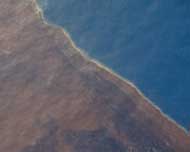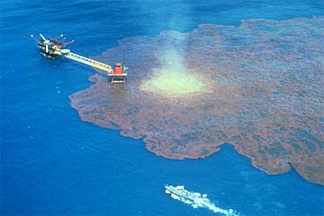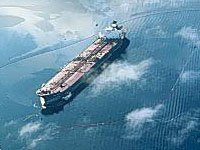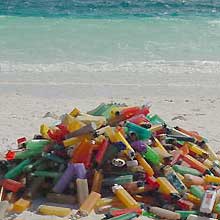|
OR&R: A History
 |
|
Leading edge of an oil spill
|
Origins of a NOAA Program
The Office of Response and Restoration (OR&R) can trace its beginning back to the late 1960s. The first National Contingency Plan (NCP) was published in 1968 in response to a massive oil spill from the oil tanker Torrey Canyon off the coast of England the year before. To avoid the problems faced by the British response personnel involved in this incident, U.S. officials developed a coordinated approach to cope with potential spills in U.S. waters. The 1968 plan provided the first comprehensive system of accident reporting and spill containment and cleanup. It also established a response headquarters in association with the U.S. Coast Guard, a national reaction team and regional reactions teams that were the precursors to the current National Response Team and Regional Response Teams.
With enactment of the Clean Water Act of 1972 (CWA), Congress subsequently expanded the scope of the NCP to address hazardous substance spills as well as oil discharges. Following the passage of Superfund legislation in 1980 (the Comprehensive Environmental Response, Compensation and Liability Act), the NCP was further expanded to cover releases at hazardous waste sites requiring emergency removal actions. The latest revisions to the NCP were finalized in 1994 to reflect the provisions of the Oil Pollution Act of 1990 (OPA).
In 1976, as part of its Outer Continental Shelf Environmental Assessment Program (OCSEAP) to study the effects of oil and gas exploration in Alaska, NOAA established the Spilled Oil Research (SOR) Team. HAZMAT's precursor, the SOR Team was a network of coastal geologists, marine biologists, chemists, and oceanographers. When an oil spill occurred, the SOR Team would mobilize quickly and go on-scene at these "spills of opportunity" with the goal of gaining information to help minimize damages from future spills.
In December 1976, the 640-foot Liberian-flag tanker Argo Merchant ran aground near Nantucket Island directly over Georges Bank, which, at that time, was one of the world's most productive commercial fishing areas. Bound for Salem, Massachusetts from Venezuela, the tanker carried 7.5 million gallons of residual fuel oil in one of its thickest, heaviest forms. Both government agencies and the scientific community recognized the seriousness of the situation. However, the Coast Guard, charged with directing the spill response and cleanup effort, was inundated with competing and often conflicting recommendations from all sides. Accordingly, the Coast Guard asked the SOR Team, with its established operational experience with spill response, to act as an informal liaison with the scientific community at the spill.
 |
|
Ixtoc I well blowout, 1979
|
This informal relationship rapidly established its value; the Coast Guard began to rely on this well-organized, experienced team to coordinate responses to the complex scientific issues that arose at subsequent spills. The SOR Team, while continuing to investigate oil spill phenomena, acted as the Coast Guard's scientific advisor at spills that followed the Argo Merchant, including: the Metula off Tierra del Fuego, Chile; the Amoco Cadiz, off the Breton coast of France; and the IXTOC I well blowout in the Gulf of Mexico in June 1979. By that time, the SOR Team had been renamed the Hazardous Materials Response Project or HAZMAT.
In 1982, revisions to the National Oil and Hazardous Substances Pollution Contingency Plan (NCP) formally codified NOAA's role as coordinator of scientific activities during spill emergencies. The revisions specifically designated certain federal officials to act on behalf of the public as trustees for natural resources. NOAA designated nine Scientific Support Coordinators, or SSCs, to coordinate scientific information and provide critical support to the U.S. Coast Guard, and other federal on-scene commanders (FOSCs).
In addition, the NCP also defines a process for identifying state and tribal trustees, as well as the role of foreign trustees. The National Contingency Plan specifically directs the Secretary of Commerce, who delegated this authority to NOAA, to act as a trustee for natural resources managed or controlled by DOC, and for natural resources managed or controlled by other federal agencies that are found in, under, or using water navigable by deep draft vessels, tidally influenced waters, or waters of the contiguous zone, the exclusive economic zone and the outer continental shelf.
In the early 1980s, NOAA and EPA recognized the need to coordinate their efforts to define and redress environmental impacts on coastal resources from Superfund sites. By the mid-1980s, HAZMAT's Coastal Resource Coordinator (CRC) program had emerged. The CRC program placed officials in ten EPA regions across the country to emphasize the need to create working relationships with other federal and state agencies, and to help them understand their responsibilities as trustees. The CRC program pioneered the use of comprehensive environmental evaluation to identify and redress impacts from hazardous waste sites. It was soon apparent that this expertise in ecological concerns and contaminant effects gave EPA the technical depth to make informed decisions on the whole complex suite of waste site cleanup issues.
 |
|
Exxon Valdez oil spill, 1989
|
The Exxon Valdez oil spill in 1989 spawned a NOAA decision, through an Exxon/Oil Pollution Act (OPA) mandate, to establish a more formal organization that could coordinate resources and expertise toward fulfillment of the agency's natural resources trustee responsibilities. In 1990, the Damage Assessment and Restoration Center was established and shortly thereafter developed into the Damage Assessment and Restoration Program (DARP). DARP is comprised of three different offices across NOAA: the Damage Assessment Center (DAC) within the NOS/Office of Response and Restoration; the Restoration Center within the NMFS/Office of Habitat Conservation; and the Office of General Counsel for Natural Resources. Since it was established, DARP has generated over $300 million for restoring natural resources injured by releases of oil and other hazardous materials, and physical impacts to resources of national marine sanctuaries. As a result of DARP, NOAA is recognized as the nation's leader in natural resource damage assessment and is looked to by other federal, state, and tribal trustees for guidance and training.
From the beginning, HAZMAT was conceived as an organization with two roles. First, HAZMAT responds to urgent environmental problems, dealing with scientific issues in a direct, pragmatic way. Second, HAZMAT conducts research to develop new and improved ways to respond to problems, taking advantage of its planning, evaluation, and response operations to identify problems, test possible solutions, and transfer its knowledge to others.
Following the National Ocean Service (NOS) reorganization, HAZMAT went through a reorganization of its own, and on February 28, 1999, OR&R was officially formed. The former HAZMAT division joined forces with the Washington, D.C.-based DAC to form the Office of Response and Restoration (OR&R). As a program office headquartered in Silver Spring, Maryland, OR&R achieved higher visibility and representation at NOAA that increased its influence and effectiveness.
At the point of the reorganization, the Hazardous Materials Response and Assessment Division was comprised of three branches: SSC, MASS, and CRC. As part of the reorganization, the SSC and MASS branches were combined into the Hazardous Materials Response Division. The formed Coastal Resource Coordination program became the Coastal Protection and Restoration Division (CPRD) and the Damage Assessment Center (DAC) joined OR&R, both as part of the organization, but even more importantly, as a logical extension of the activities being conducted by HAZMAT and CPRD on oil and chemical spills and hazardous waste cleanup and restoration.
In 2002, the OR&R Director, David Kennedy, was made Matrix Program Manager of the Coral Reef Conservation Program (CRCP), essentially assigning leadership of this NOAA Matrix Program to OR&R. Though with separate responsibilities and budget, the CRCP sits with OR&R in Silver Spring and uses the same support personnel.
In 2004, OR&R began a new reorganization to better align activities between response and restoration. The reorganization was finally approved and made official in June 2006. The reorganization gives OR&R only two divisions, the Emergency Response Division (ERD), and the Assessment and Restoration Division (ARD). To create a more cohesive program, support personnel including secretaries, cost documentation, and Information Technology was consolidated into the Business Services Group, instead of being housed within each division.
In May 2006, David Kennedy accepted the position of Office Director, Office of Ocean and Coasts Resource Management (OCRM) and brought with him the management of the Coral Reef Conservation Program.
 |
|
Plastic debris gathered from a beach
|
On December 22, 2006, President Bush signed into law the Marine Debris Research, Prevention, and Reduction Act, which legally establishes the NOAA Marine Debris Program. The Act authorizes the Marine Debris Program, within OR&R, to reduce and prevent the occurrence and adverse impacts of marine debris on the marine environment and navigation safety.
Today, OR&R is a center of expertise in preventing, planning for, evaluating, and responding to releases of oil, hazardous substances, and uncontrolled hazardous waste sites in coastal environments. The Program is also responsible for the development and implementation of a centralized program that addresses the issue of marine debris for the agency as a whole, and supports NOAA's role in the U.S. Ocean Action Plan. OR&R has responded to a variety of environmental crises, ranging from the Exxon Valdez spill; the oil spills in the Persian Gulf conflict; the rescue of Humphrey, the whale; the spill of about 60 thousand tons of soybeans into Alaskan waters; and the destruction of Hurricanes Katrina and Rita. OR&R works exhaustively to ensure that coastal habitats damaged by hazardous waste contamination are restored as completely as possible. Finally, OR&R passes on the results of its experience through seminars in which it emphasizes fieldwork and operational "lessons learned."
OR&R continues to grow and achieve success in all aspects of its mission. Through the diligent protection of NOAA Trust Resources and the dedication of its personnel, the Office of Response and Restoration is committed to finding comprehensive solutions to environmental hazards caused by oil, chemicals, and marine debris.
For more information
|
- OR&R Media Archive To learn more about the Office of Response and Restoration (OR&R), read some of the news articles that have been written about our work over the years.
|
|


